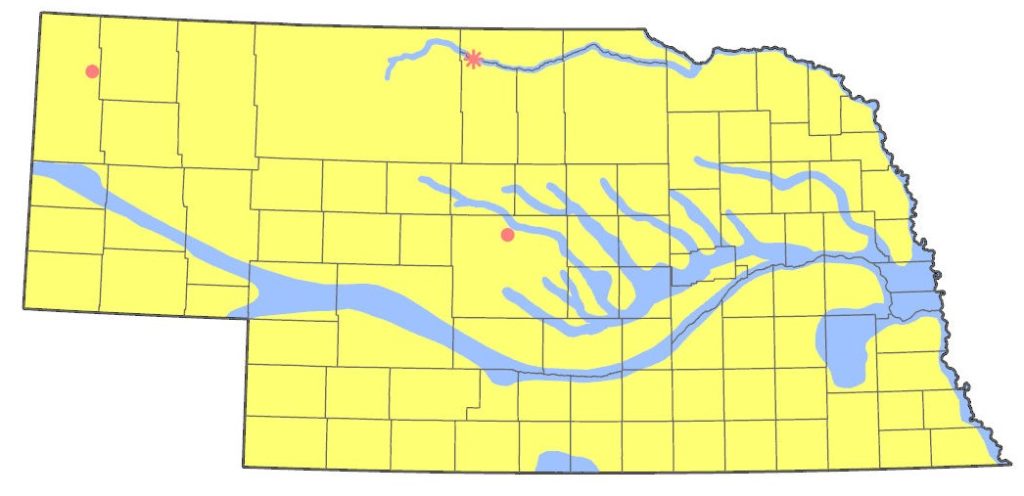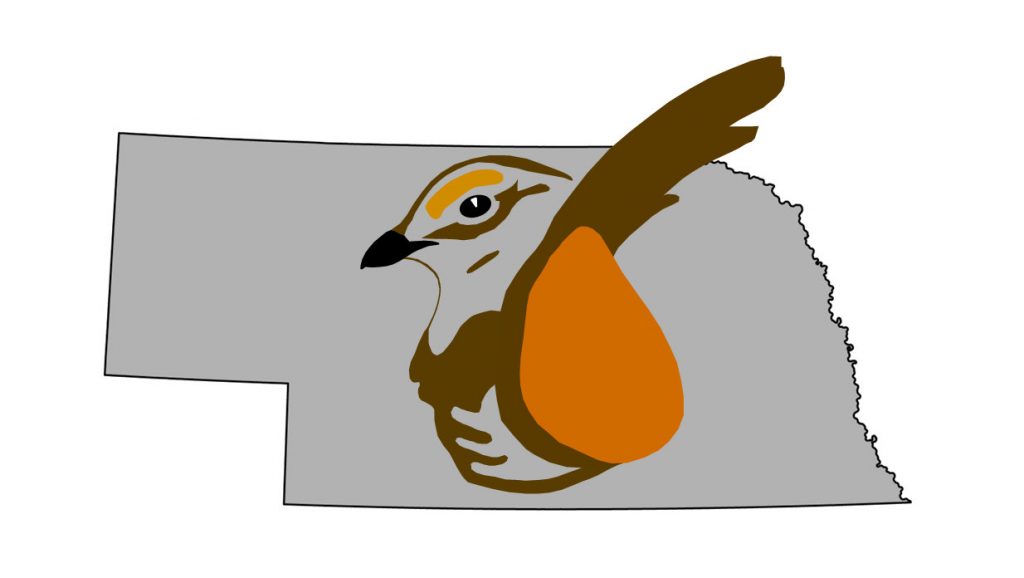Mergus merganser americanus
Status: Common, locally abundant, regular spring and fall migrant statewide. Rare casual summer visitor statewide. Rare regular breeder central, accidental west. Fairly common, locally abundant, regular winter visitor statewide.
Documentation: Specimen: WSC 522, fall 1975 Madison Co.
Taxonomy: Three subspecies are generally recognized, merganser and orientalis of the Paleartic and americanus of the Nearctic (Johnsgard 1975, Gill et al 2022).
Nebraska birds are americanus.
Changes since 2000: Breeding has become annual in a stretch of the Niobrara River within the Niobrara Valley Preserve, Keya Paha and Brown Cos. Reports continue to clarify the presence of apparent molt migrants at a few locations; this phenomenon was first noticed in the 1970s.
Spring: winter <<<>>> Jun 5, 6, 8
Late dates above are away from Keith Co. See Summer for dates after 8 Jun.
It is difficult to separate winter visitors from early migrants, although there is a discernible increase in numbers in late Feb, peaking in mid-Mar. Few linger into May, although as many as 24 were at Lake Ogallala 19-31 May 1997.
- High counts: 200,000 at Harlan County Reservoir, Harlan Co 14 Mar 2003, 4000-5000 at Branched Oak Lake, Lancaster Co 14 Mar 2010, 4000 at Lake McConaughy, Keith Co 24 Mar 1989 (Rosche 1994), and 3400 at Harlan County Reservoir 3 Mar 2006.
Summer: All but one of the reports suggestive of breeding are from the Niobrara Valley Preserve, Brown and Keya Paha Cos, although the earliest documented record is from Victoria Springs SRA, Custer Co in 1968; a male and female were present during the spring, and on 27 Jul the female was seen by several observers including E. A. Kiborz with six ducklings (Bennett 1969, Mollhoff 2022). Until 2022, all reports of breeding and possible breeding have been from a stretch of the Niobrara River within the Niobrara Valley Preserve, Brown and Keya Paha Cos. The first documented record there was of two broods near the Norden Bridge 2 Jul 2007; one brood had four half-grown untended young, the other eight downy young with an adult female (Luchsinger; Mollhoff 2022, 2008). Since 2007, there are reports of adult females and/or broods in 2009, 2012-2015, and 2017-2020. The six female-type birds there 22 Sep 2009 may have been a locally raised brood. There were 2-3 females present each year 13-22 Jun 2012-2015. An adult female with a brood was photographed 7 May 2017 and six nearly fledged young were photographed nearby 7 Jul 2017, likely the same brood. In 2018, a female with three ¾ grown young was present 14 Jun, but no breeding evidence was reported in 2019 despite the presence of 1-3 birds, including an adult male, 4-7 Jun. A female and six well-grown young were photographed 2.5 miles above Norden Bridge 21 Jul 2020. In 2021, two broods were found: a female with six young 1-2 weeks old on 6 Jun and a brood of 11 large flightless young 2-3 miles below Norden Bridge 16 Jul. A pair was loafing at Big Alkali Lake WMA, Cherry Co 5 Jul 2020; this location is about 30 miles southwest of Norden Bridge.
A new breeding location was along the White River, southwest of Crawford in Sioux Co 6 Jul 2022 where a duckling was photographed, presumably associated with an unseen brood or hen (Brett Roberg, personal communication).
Two other reports of possible breeding are of a “recent nesting record for the North Platte Valley to the west of Lake McConaughy” (Rosche 1994), and a pair at Lake McConaughy, Keith Co 31 May 1996 that was “suspected as nesting” (Grzybowski 1996). Neither report was accompanied by details, however.
There are about 33 summer (9 Jun-4 Oct) records scattered statewide, most probably non-breeding immatures and molt migrants. As an example, Lake Ogallala, Keith Co attracts this species in summer; earlier, Jun-early Jul, most are likely non-breeding immatures, but later, beginning in mid-Jul, molt migrants add to the numbers there (see Fall). Single adult males are few, reports are from 11 Jun 2017 Saunders Co, 14 Jun 2017 Harlan County Reservoir, Harlan Co, 14 Jun 2023 Sheridan Co, 15-22 Jun 2023 Lancaster Co, 19 Jun 2019 (7) Burt Co, 21 Jun 2014 Washington Co, 22 Jun 2023 Seward Co, and 1 Jul 2017 Smith Lake WMA, Sheridan Co.
Fall: Sep 26, 26, 29 <<<>>> winter
Earlier dates from sites where molt migrants are not expected are 21 Aug 1999 Oliver Reservoir, Kimball Co, three on 31 Aug 2010 Sutherland Reservoir, 4 Sep 1973 McPherson Co, 7 Sep 2016 Gavin’s Point Dam, Cedar Co, 6 and 16 Sep 2017 Sutherland Reservoir 17 Sep 2016 Calamus Reservoir, Loup Co, 18 Sep 1971 Douglas-Sarpy Cos, and 18 Sep 2010 (45) Dixon Co.
Migration begins in late Sep and early Oct, and numbers peak in Dec. Major Central Nebraska reservoirs, Lake McConaughy, Keith Co, Sutherland Reservoir, Lincoln Co, and Harlan Co Reservoir, Harlan Co, are important staging areas for this species.
In recent years, it has been recognized (Silcock 1995) that molt migrants use at least two Nebraska locations, Lake Alice in the North Platte NWR, Scotts Bluff Co, and Lake Ogallala, Keith Co. Few yearling and mature males remain on breeding grounds after mid-Jul (Palmer 1976); Nebraska molt migrants likely follow the Platte River Valleys from breeding locations in the mountains of Wyoming and western Colorado. Arrival at Lake Alice has been in mid-Jul most years since 1973, and as early as 25 Jun in 1997. Around 100-200 birds use the lake (Silcock 1995). A second location is Lake Ogallala, where up to 25 have appeared in recent years.
- High counts: 48,000 at Harlan County Reservoir 14 Dec 1997, 40,000 at Lake McConaughy 23 Dec 1994, and 36,119 there 21 Dec 2003.
Winter: Wintering birds may occur on open water anywhere in the state, but largest numbers are at major reservoirs where open water remains through the winter. High winter counts are 20,000-31,000 (two estimates) at Harlan County Reservoir, Harlan Co 13-14 Dec 2018, 15,000 at Sutherland Reservoir 11 Feb 1994 and 12,000 at Lake McConaughy 15 Jan 1998.
On the Harlan County Reservoir CBC, Harlan Co, 14 Dec 2021, a record low of 286 were tallied, where usually counts are in the order of 10,000-20,000. The low tally may have been a consequence of extensive flooding in 2019 that may have affected the food supply there (Joel Jorgensen, personal communication). Recovery of Common Merganser Numbers at Harlan County Reservoir has been slow; only 4000 were counted there 16 Dec 2024.
Abbreviations
CBC: Christmas Bird Count
NWR: National Wildlife Refuge
SRA: State Recreation Area
WMA: Waterfowl Management Area (State)
WSC: Wayne State College
Literature Cited
Bennett, E.V. 1969. 1968 Nebraska nesting survey. NBR 37: 39-46.
Gill, F., D. Donsker, and P. Rasmussen (Eds). 2022. IOC World Bird List (v 12.2). Doi 10.14344/IOC.ML.12.2. http://www.worldbirdnames.org/,
Johnsgard, P.A. 1975. Waterfowl of North America. Don Mills, Ontario: Fitzhenry & Whiteside.
Mollhoff, W.J. 2008. The 2007 Nebraska nest report. NBR 76: 155-165.
Mollhoff, W.J. 2022. Nest records of Nebraska birds. Nebraska Ornithologists’ Union Occasional Paper Number 9.
Palmer, R.S., ed. 1976. Handbook of North American birds. Vol. 2. Waterfowl (Parts 1 and 2). New Haven, CT, and London: Yale University Press.
Rosche, R.C. 1994. Birds of the Lake McConaughy area and the North Platte River valley, Nebraska. Published by the author, Chadron, NE.
Silcock, W.R. 1995. Summer Field Report, June-July 1995. NBR 63: 70-82.
Recommended Citation:
Silcock, W.R., and J.G. Jorgensen. 2025. Common Merganser (Mergus merganser). In Birds of Nebraska — Online. www.BirdsofNebraska.org
Birds of Nebraska – Online
Updated 7 Mar 2025, map updated 8 Mar 2023
